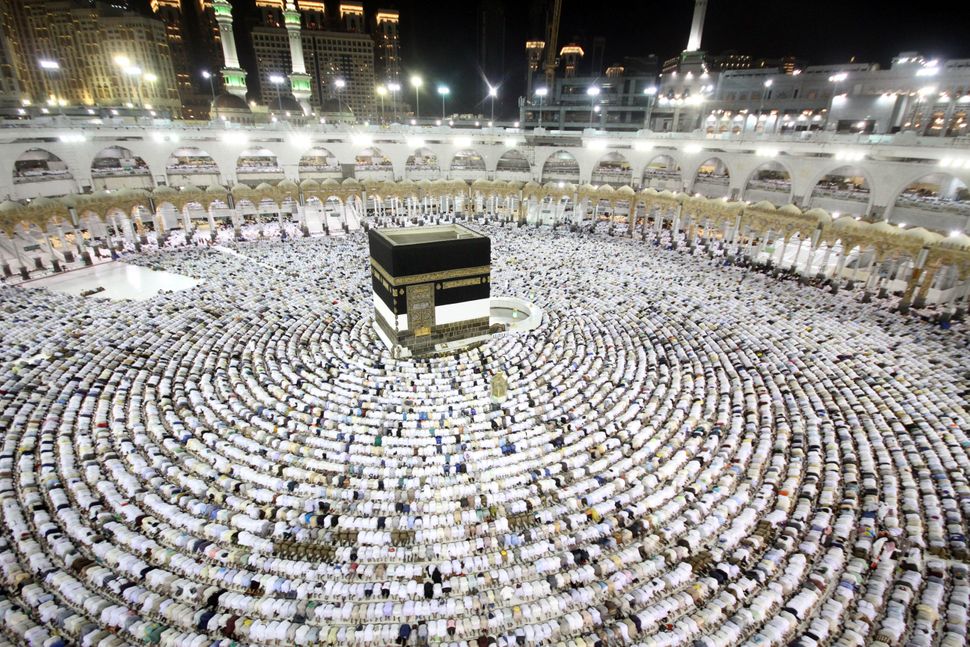
Description of hajj
- Assuming the state of ihram from Miqat. It is legislated for whoever wants to perform hajj or Umra to perform ghusl, remove the unwanted hairs from his armpits and private parts, trim his nails, apply perfume and then proceed to the Miqat. If it is time of prayer when he arrives he should pray , or, if not, then he may pray two rak’ahs if it is possible, then he assumes the state of Ihram. As for the menstruating woman, or the one who is undergoing postpartum bleeding, then she performs ghusul before assuming the state of ihram as mentioned in Sahih Muslim(1209), that the prophet(PBUH) ordered Asma bint Umays (May Allah be pleased with her) to perform ghusul when she was experiencing postpartum bleeding. And the one who is menstruating is similar in that ruling.
- When the pilgrim intends hajj or umrah, he mentions that which he wishes to perform. So he says, “Labbayk Allahuma umratan mutamatti’an biha ilal hajj,” if he wishes to perform tamattu. Or he says, “Labbayk hajjan wa umrah,” if he intends Qiran. Or he may say, “labbayk hajjan,” if he intends Ifrad. And tamattu’ is the best of them. Then he says rhe talbiyah with tawhid, “Labbayk Allahumma labayk, Labbayk la sharika laka labayk, innal-hamda wan-ni’mata laka walmulk, laa shariika laka.” He should say the talbiyah frequently, especially if he ascends a high place or descends to low one. He should also speak little, except when in a need to do so. His heart should be mindful of what he is saying (i.e. the talbiyah), so that he may obtain khushu (Humility, submission, fear).
- When he reaches al-Masjid Al-Haram he enters with his right foot, and say that legislated dua entering the masjid, by sending salams unto the prophet (May Allah’s blessings and peace be upon him), then saying, Allahumma-ftah li abwaab rahmatika. Then he performs al-idtiba’, which is putting the middle of his upper garment below his right armpit, and its ends over his left shoulder. Pellentesque ornare sem lacinia quam venenatis vestibulum. Aenean lacinia bibendum nulla sed tur.Cras mattis consectetur purus sit amet fermentum. Sed posuere consectetur est at lobortis. Nulla vitae elit libero, a pharetra augue consectetur purus sit amet ferment
- He then proceeds to the black stone, kisses it if that is easy, or he touches it wth his hand. Or with a stick and kisses that. If it is not possible he simply points to it with his right hand and say, “Allahu Akbar”. He then begins Tawaf, with the K’abah on his left side. He performs raml2 during the first three circuts, then he walks normally during the last four. If possible, he touches the Yemeni corner (i.e. the corner before the on which contains the black stone with his hand, without kissing it. It is not possible then he does not point to it. Tawaf doesn’t have any specific Adhkar (remembrance), with the exception of what is said between the Yemeni corner and the Black Stone, “Rabbana atina fiddunia hasanah, wa fil-akhirati Hasanah, Wa qina adhaaban nar.” As for other than that then he may make dua for anything, as long as it doesn’t contain sinning or cutting the ties of kinship.
- Upon completing the seventh circuit, he heads towards Maqam Ibrahim, and stands with it between him and the Ka’bah. He prays two rakahs, reciting surah al-Kafirun in the first, he may pray in any part of Maqam Ibrahim, he may pray in any Behind Maqam Ibrahim, he ma pray in any part of the masjid.
- He then drinks his fill of zamzam, then heads towards as-safa. Upon reaching it he recites, “Innas-safa wal-marwata min sha’a irillah. Faman hajjal-bayta awitamara fala junaha alayhi ay-yattawwafa bihima” (Indeed As-safa and Marwah are of the symbols of allah. So it not a sin on the one who performs Hajj or Umrah to perform sa’y between them).” He then ascends as-safa, faces the Ka’bah, raise his hands, says, “Allahu Akbar” and “Alhamdu lillah” three times, then says, “La ilaha illallahu wahdahu, anjaza wa’dahu wa nasara ‘abdahu wa hazamal-ahzab wahdah (there is none worthy of worship except allah alone, he fulfilled he promise, aided his servant, and defeated the confederates by himself)”, three times, making dua between theem. He then descends, heading towards al-Marwah. Upon reaching the first green light he jogs, until he reaches the second one, sfter which he continues towards al-Marwah, waking. After ascending Al-Marwah he does that which he did at as-safa until he completes seven circuits. Going from as-safa to al-Marwah is considered on circuit, returning from al-Marwah to as-safa is considered another.
- When he finishes the seventh circuit, he will end up at al-Marwah. If he is performing Tamattu’ he then cuts his hair and upon doing so his ‘umrah would be complete, he is considered out of state of ihram, and may wear his normal clothes. However, if he is performing Qiran or Ifrad he doesn’t cut his hair, but instead he remains in a state of ihram.
- On the 8th of Dhuru hijjah (Yawm at-Tarwiyah), he performs ghusl, applies perfume, assumes the state of ihram from the place where he is staying, and begins saying the talbiyah. He then prays Zuhr, Asr, Magrib and Isha’ in Mina, shortening Zuhr and Asri. Does not join them, but instead, prays each prayer in its fixed times.
- After sunrise on the 9th of Dhur Hijjah he heads towards ‘Arafah. If it is possible to stay at Namirah he doeas that. Namirah is a valley Outside of ‘Arafah in which the prophet’s (May Allah’s Blessing and peace be upon him) tent was set up. If staying at Namirah is not possible, he goes to ‘Arafah.
- After the sun reaches its pinnacle, he prays zuhr, and Asr at the beginning of the time of Zuhr, with a single Adhan and two Iqamahs. If he was outside ‘Arafah he enters its boundaries. If possible he stands with the mountains between himself and Qiblah. This is better, as it was where the prophet (May Allah’s Blessing and peace be upon him) stood. However, if it is difficult then all of Arafah is a place of standing, as the prophets (May Allah’s blessing and peace be upon him) said, “I stood here, and all Arafah is a place of standing, but do not stand at ‘Uranah (i.e. it is not within ‘Arafah).”
- After Praying he busies himself with dhikr, dua, seeking forgiveness and reading the Quran, so that he may perceive the greatness of this day of ‘Arafah. It is a day in which Allah’s mercy descends on his servants, a lot of them are freed from the fire and Allah boosts to his angles about hos pilgrims.
In sahih Mulsm, A’ishah (May Allah be pleased with her) narrates, that the prophet (May Allah’s blessings and peace be upon him) said, “There is no day on which Allah sets free more slaves from Hell than he does on the day of Arafah.”
There is no day in which shaytan is seen more defeated, insignificant, and humiliated than on the day of Arafah, except that which occurred on the day of (the battle of) Badr.
This is due to what he sees of Allah’s generosity, well-treatment towards his servants, and his abundance of freeing them from the fire and forgiveness.
source article is: https://www.welitravel.com
